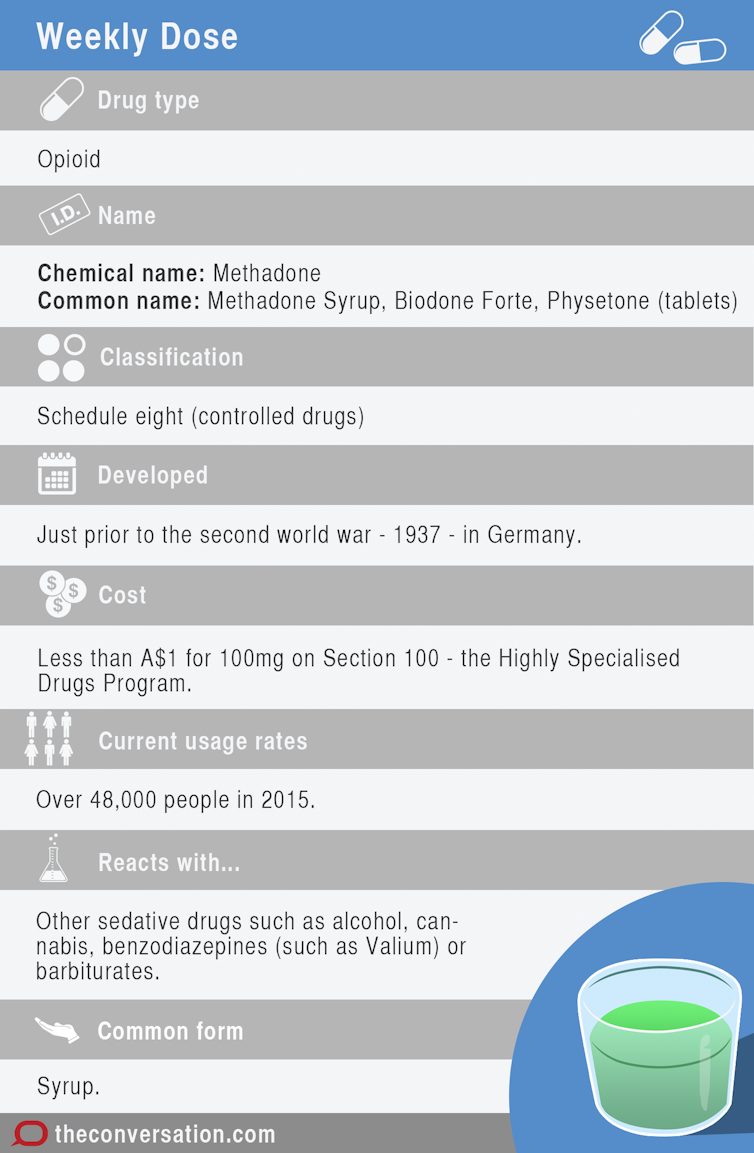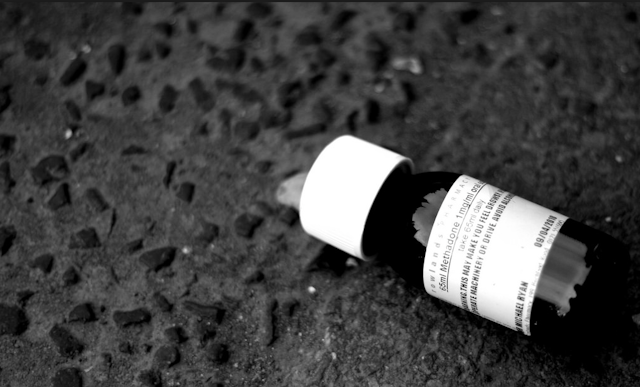Methadone is a synthetic drug that acts like drugs derived from the opium poppy (“opioids”). It is well absorbed when swallowed in a single dose, lasting about 24 hours.
Methadone is used mainly to treat heroin dependence, but also dependence on other opioid prescription drugs. It is sometimes used to treat severe chronic pain.
The drug is legal, can be taken by mouth and once-daily doses make it easy to supervise. It is used in over 80 countries. In about half of these, methadone treatment is provided in prisons.
In 2015, Australia had over 48,000 people on opioid substitution treatment. The number is increasing by about 5% a year.
Methadone is used in clinics, pharmacies, hospitals and prisons in most Australian states and territories. Most people require treatment for a few years. Often treatment is interrupted and therefore consists of multiple episodes.

How it works
After methadone attaches to the opiate receptors in the brain, many functions in the body are initially slowed (such as breathing and bowel movements) and pain is decreased. Later, the body learns to “tolerate” methadone, so the effects decrease.
Methadone is very soluble in fat and this makes absorption after swallowing very rapid. Methadone quickly enters the body’s fatty tissues, which slowly release it after methadone levels in the bloodstream start dropping. This is what makes methadone last so long.
People who take heroin after having taken an adequate dose of methadone for a couple of weeks will feel little or no effect of the heroin. Higher methadone doses for longer periods achieve better outcomes.
Some patients on methadone treatment have severe physical and mental health problems and are socially isolated. Psychological treatments can be helpful for some but are often made mandatory for all. Encouraging education, training and employment and improving parenting should be important parts of opioid substitution treatment but rarely get the attention they deserve.
The benefits of opioid substitution include reduced overdose deaths, reduced deaths overall, reduced HIV infections, reduced hepatitis C infections, reduced drug use, reduced crime and improved social functioning.
Methadone treatment is one of the most frequently evaluated interventions in medicine. The World Health Organisation and other UN bodies with a major responsibility for illicit drugs policy have endorsed the treatment.
How it was developed
German scientists developed methadone just before the second world war when access to Asian opium was threatened. The German military wanted to ensure they had a powerful drug to treat severe acute pain.
Professor Vincent Dole and Dr Marie Nyswander from Rockefeller University in New York pioneered the use of methadone to treat heroin dependence in 1964. Dole was awarded the Lasker prize for major contributions to medical science for this work (Nyswander had unfortunately passed away at this time).
Dr Stella Dalton began using methadone to treat heroin dependence in Sydney in 1969 and this was accepted officially in Australia in 1970.
Methadone treatment was initially extremely restrictive and punitive in Australia and internationally. Doses were too low, treatment much too short and patients were treated punitively. Treatment also often ignored or contradicted clear findings from research in that treatment duration was often subject to arbitrary restriction, doses were reduced if there was evidence of heroin use, and frequent supervised urine drug testing was demanded despite the cost and lack of evidence of benefit.
These days, treatment has been expanded, but unmet and deterred demand is still substantial. Higher doses and longer duration of treatment are now used and treatment is less punitive. Incremental improvement is increasingly valued without requiring rapid achievement of abstinence from heroin.
Although treatment is much improved in Australia, there is still a long way to go.
How much it costs
The drug methadone is very inexpensive. A 100mg dose costs less than A$1.00.
Staff costs account for most of the cost of opioid substitution treatment in Australia. The average cost of methadone treatment per person, when provided by GPs, was estimated in 1995 to be A$737 in the first year of treatment and $367 in subsequent years. But when psychiatrists provided opioid substitution treatment these costs were A$2,189 and A$1,267 respectively.
It is estimated that for every dollar spent on methadone treatment, A$4-$7 is saved for the community by reductions in the cost of health care and crime.
In Australia, people undergoing opioid substitution treatment mostly pay at least A$35 per week for this treatment. As most people taking methadone have very low incomes, the high cost delays treatment entry and accelerates exit from treatment, damaging treatment outcomes.
How it makes you feel and what it could react with
People on methadone feel like they have taken an opioid, with a slight sense of euphoria. This feeling reduces the rate of treatment attrition but upsets detractors because it involves treating a person with a drug addiction with another drug of addiction.
When a person taking methadone takes other sedative drugs such as alcohol, cannabis, benzodiazepines or barbiturates, the sedative effects are additive and can result in an overdose. Many people using street heroin consume these drugs at high risk.
What are the side effects?
Common side effects of methadone include constipation, sweating, impotence in males (at higher doses), loss of libido in males and females, and severe withdrawal symptoms when methadone is stopped abruptly.
Overdose deaths in children of parents on methadone treatment have occurred. Understandably, these cause considerable concern, resulting in vigorous efforts to minimise such deaths.
A controversial treatment
Methadone is often very controversial for decades after being introduced to a country. In Australia, the controversy over methadone treatment is largely over, although implacable opponents of harm reduction still occasionally question the treatment.
Methadone treatment does not appeal to all users of heroin or prescription opioids, and may be inappropriate or ineffective for some. But it is better supported by evidence of effectiveness and is also very cost-effective.

